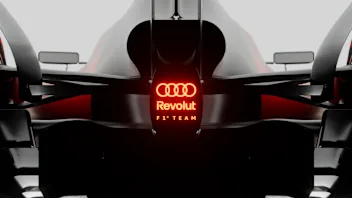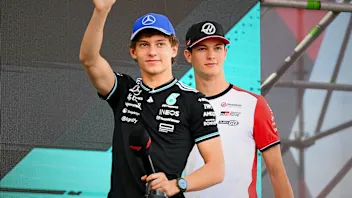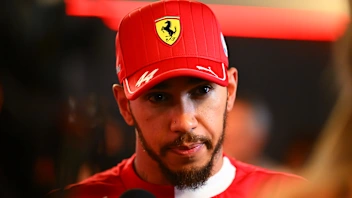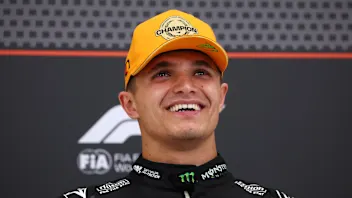Coming on strong - Q&A with Force India's Otmar Szafnauer
Sweeping rule changes shouldn’t favour the smaller teams, but Force India have bucked the trend in 2014, entering the summer break on the back of the strongest opening to an F1 campaign in their history.
In a candid and exclusive interview, Force India chief operating officer Otmar Szafnauer reveals how the Silverstone-based squad have profited as others have struggled, but also explains why maintaining such high levels could prove increasingly difficult…
Q: One podium, fifth in the constructors’ standings, and - until Hungary - points in every single race. Did you have any idea you would start 2014 this strongly?
Otmar Szafnauer: I don’t think so. We didn’t know, for example, who would do the best job at developing the power unit. That said, we did have a choice and we went with Mercedes because we thought they would do the best job, even if we didn’t know by how much. But we started development early, in May, so our expectation was that we would perform well - we just didn’t know how well.
Q: What was the thinking behind starting so early? Is that why the team’s form tailed off at the end of 2013?
OS: A little bit. Our form was mainly down to Pirelli changing construction of the tyres mid-season. Other teams reacted to that and we didn’t, the reason being that by the time the changes were made, we were well down the road with developing this year’s car. We had a dilemma: do we stop what we’re doing for 2014 and react to the new tyres, which would have taken us a while, or do we just continue? Had we tried to react, it would have had a bigger impact on this year’s car than what we could have gained last year. The only thing we could have gained was beating McLaren to fifth, and that was close anyway. So the potential upside was one position, but the downside this year would have been huge.
We started early [with the 2014 car] for a number of reasons. One, we thought it would be a strategic advantage to do so. Second, our resources aren’t as great as some of our rivals. Had we started late, we wouldn’t have been able to do some of the experiments which helped us decide what direction to take - we just can’t do everything at once like some other teams. Also, like I said, we were in a pretty good place with last year’s car - that helped.
Q: What were some of the experiments, or decisions, that you made early on?
OS: The big thing was cooling the power train. There are a lot of trade-offs between cooling the power train; between gaining horsepower and losing aerodynamics. You have to run those trade-offs in CFD [Computational Fluid Dynamics] and in the windtunnel. If you over-cool you don’t gain any more power, but you lose aerodynamic efficiency. If you go the other way, you’re more efficient but you lose power. That is an iterative process: you learn it through a logical series of increments, not just up front. If you have a lot of resource, say 30 teraflops of CFD, 150 people in the tunnel and two tunnels at your disposal, you can do it quicker. But what you want to do is get it right, because if you get it wrong it has a big impact. Think of it like a tree: there is low hanging fruit, so you learn a lot at the beginning, but towards the end you learn less and less. Where do you want to stop that learning?
Q: So did you know you were in good shape early on? There is a saying in F1 racing that the decisions you made 18 months ago shape where you are today…
OS: Absolutely. We had a good feeling. We knew what Mercedes were doing because we had a dialogue - we signed a long-term contract with them so they would tell us - but what you don’t know is what the others are doing. You have to guess at what is likely to happen to them. But you know what you are doing…
Q: And how important has the Mercedes power unit been? Force India were free to choose this year, and you were pretty instrumental in the final decision…
OS: Yeah. There were a couple of things: Mercedes in years past have spent a lot of time, effort and resource in having infrastructure that allows development of the power train without doing track testing, and our assessment was that others perhaps hadn’t invested as much into that area. So we knew they had the capability and infrastructure required to do a new power train without a lot of track testing. We thought that would give them an advantage. We also knew Mercedes would do the entire power train themselves - they wouldn’t be buying bits from outside - and integrating it was key. And a third thing was that we had very good relationship with them, they provided good power trains for us in the last four or five years we have been with them, and they are also based just up the road [from Force India]. So those are the reasons. The last was secondary, but it played a part.
Q: But it isn’t all about the power unit, as demonstrated by the fact you are above McLaren in the constructors’ fight. How difficult is it to fight with teams with greater resources? How do you manage it?
OS: Yes, it’s not just that. We’re ahead of McLaren, they have more resources, a better tunnel, better simulator - you can go on. Williams are the same. The only way we compete is to take those disadvantages, understand what we do have and the limits of what we have, and make it up in the fact we pull together more, we have better people or people who understand the resources we have and can gain the most out of them. That’s the only way we can compete really. We have decent drivers: comparing them as a combination to the other Mercedes teams, apart from maybe Lewis (Hamilton) and Nico (Rosberg) we’re there, if not a little bit higher, than the others and that helps too.
Q: How have your rated your all-new driver line-up this year?
OS: Brilliant. Just brilliant. We have a very good relationship, a long-standing one, with Nico (Hulkenberg). He is very intelligent, has good feedback and helps us develop the car. Sergio (Perez) has fitted in very well in his first year. He is a very quick racing driver, especially in the races. He finished on the podium and Nico has scored in every race, so they’ve both done a very good job.
Q: Have you been surprised with how well Perez has got on compared to Hulkenberg?
OS: Well, if you look at his past history, he did well at Sauber before McLaren took him, and he was against Kobayashi who is no slouch. And in the second half of 2013, he kind of took it to Button, especially in the races. But he also out-qualified Button, 10-9 over the year - and Sergio is typically stronger in the races than he is in qualifying. Nico has been consistent and outscored Sergio, but Sergio has been unlucky, like contact with Massa and when he couldn’t get out of the garage to start in Malaysia. Am I surprised at his form? Not really. He is focused, wants to do well and is a good driver. I think we’ve got a good combination, and they’re both brilliant at driving the team on.
Q: You have tended to be more competitive in races than in qualifying this year. Is that a deliberate ploy, or do you need to improve on Saturdays?
OS: I don’t think it is a priority of strategy, but if we have choices to make between gaining a few places on Saturday or being set up for Sunday, we will always choose the latter - at least in places where you can overtake. At circuits where you can’t, qualifying becomes more important and we will change the balance. But there is no sense in looking good on Saturday and going backwards Sunday; we don’t look at it that way. One nice thing about this team is that it is made up of a bunch of racers, people who want to do well on Sunday, and because of that we take those decisions to try and maximise everything around being as high as possible on Sunday.
Q: We’ve also seen just how close the midfield battles can be. How do you plan to keep Force India in the fight?
OS: From a car perspective, Silverstone was probably our first big upgrade package. We had some of it in Austria and all of it in Silverstone. That was a big upgrade - new rear wing, new front wing, new floor, new sidepods. That was the first big step for us. We have another couple of big increments planned - you have to otherwise you slip back. We will typically bring three or four in a year, so on average that will be every five races. But Austria was the first big one, and that was the eighth race - so expect three or four big upgrades and a few smaller ones along the way in the autumn.
Q: How does the relative stability of the 2015 regulations affect your plans?
OS: It is stable - apart from the front nose area - and when you have that, you try and bring the developments to the car as soon as possible, because they will also apply to next year’s car. There is no sense trying to trade off one year for the other - just bring them.
Q: Just as 2014 was an opportunity for you, is the stability of 2015 therefore likely to hurt you?
OS: Maybe. It could be a bit more difficult - or we have to be a bit smarter. With the infrastructure we have, once you get to a point of diminishing returns I think other teams are in better shape because the fidelity of our tools isn’t quite as high as the fidelity of theirs. Teams with more money can do more experiments - that’s why we started early this year. It’s no secret that Mercedes have done a good job [this year] - they'll improve, but others will improve marginally more too, so it will all come closer together.
Q: Do you think the Mercedes power unit layout will be copied then?
OS: Yes. I don’t understand the strategic direction of the other power units, but I’m sure that in Formula One everyone looks at what everyone else is doing, and if they believe there is something they’ve missed, which they now know… that’s just how our industry works.
Q: Is it all about the power unit this year?
OS: I don’t think so. To win you have to get it all right. Look at Mercedes - I believe that their car would still be good enough to win even with Renault or Ferrari power. They have a good aero package, good mechanical package, they understand the tyres, have good drivers and strategy - they're going to win. Remove the powertrain and stick another one in and they’ll still be competitive. Is it more of an engine formula this year? Maybe a bit more than in the past when the engines were all frozen. But is it a complete engine formula? No way. We have the same engine as Mercedes, so do Williams and McLaren - and they’re not winning.
Q: What’s your take on the new era of Formula One racing then, looking at it on the basis of the first half of the season?
OS: You have to ask yourself how important is it to the fans that F1 technology leads road car technology? That’s hard for me to answer. In years past F1 has always led car technology, because what happened in F1 was always naturally ahead of road cars - road cars were always looking for more power, more power density. But now with road cars having enough power and fuel prices soaring, people are looking for more efficiency - they want to bring the costs down. Should F1 lead that? We now have hybrid power, reducing fuel consumption by around 33 percent. That is a huge reduction within the space of a year, and the cars are still as fast and powerful as they have been in the past. Is that right for F1, or should we have stuck with what we had? Or should F1, as the highest level of motorsport, be about entertainment and good racing? I would say if you can do both, why not? That’s what we’ve seen this year - that you can have great racing, like in Bahrain, or Canada, or Austria, and also have the technology that leads road cars. I was sceptical at first, but we’ve seen this year that you can do both.
Next Up
Related Articles
 ‘I have achieved my dream, that little boy's dream’ – Norris
‘I have achieved my dream, that little boy's dream’ – Norris Audi announce team name and global launch date for 2026 challenger
Audi announce team name and global launch date for 2026 challenger Piastri 'will be a world champion' in future – Norris
Piastri 'will be a world champion' in future – Norris JacquesHow did the rookies do in their first F1 season?
JacquesHow did the rookies do in their first F1 season? Hamilton 'doesn't have a mindset' for 2026 after tricky year
Hamilton 'doesn't have a mindset' for 2026 after tricky year Norris hopes title win doesn’t change him as a driver
Norris hopes title win doesn’t change him as a driver